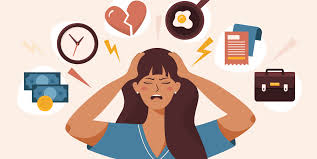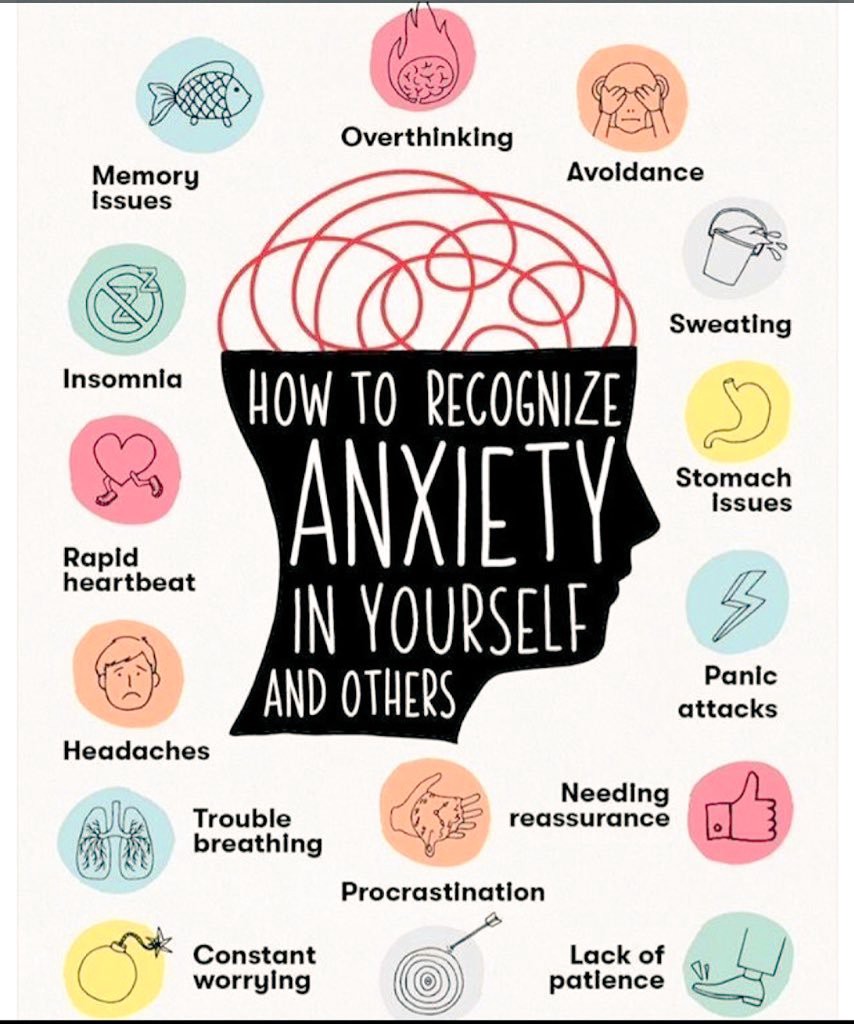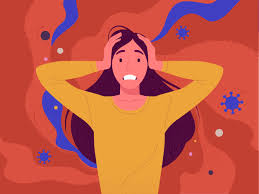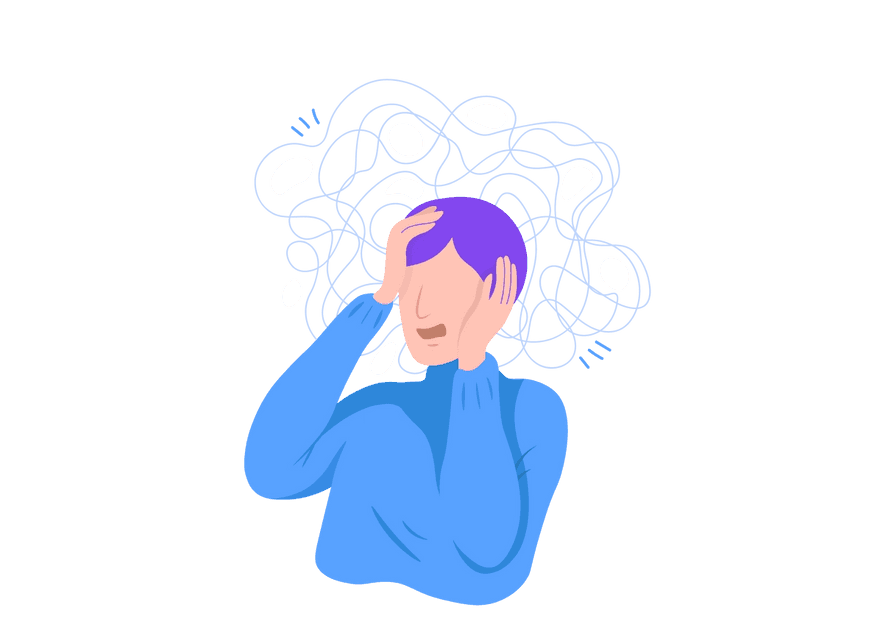Anxiety is a very real mental illness that affects millions of people throughout the world. However, many are unaware of what anxiety is, how it feels like, its different types and degrees. Or even what causes this debilitating condition. So, if you are struggling with anxiety attacks or have an anxiety disorder yourself, then you need to read this post! It will provide you with all the information you need about managing your symptoms.
Contents
Understanding Anxiety

This condition can be defined as a group of mental and physical symptoms that are typically related to stress. It’s characterized by feelings of worry, fear, or uneasiness due to anticipation about some coming event (whether real or not). Hence, it implies anxiety can also occur for no apparent reason at all.
How Does Anxiety Feel Like

Anxiety is unique to each person who experiences it. Some people may feel a sense of dread or panic. While others may feel restless, jumpy, and on-edge. Thus, it’s important to remember that everyone’s experience with anxiety is different.
Degrees Of Anxiety
In many cases, anxiety can be classified into two degrees: mild and severe.
- Mild anxiety is typically situational (e.g., giving a speech or starting a new job). It’s the type of condition that anyone may experience from time to time due to some life event or occurrence.
- Severe anxiety on the other hand usually requires treatment. It’s often associated with some form of anxiety disorder. And may even interfere with the person’s ability to function daily.
Causes Of Anxiety
Many things can cause someone to have an anxiety attack or be characterized by an anxiety disorder. Some common causes include:
Genetics/Heredity
Many mental health disorders, including anxiety and depression, run in the family. There is evidence that having a parent or sibling with an anxiety disorder can increase one’s chances of developing this condition themselves.
Environment
People who have been abused during their childhood are at greater risk for experiencing panic attacks when they’re older. This is because these individuals may associate certain environments or situations with the traumatic event.
Brain Chemistry
People with anxiety disorders often have imbalances in neurotransmitters. These are chemicals that brain cells use to communicate with each other. This may account for some of the intrusive thoughts and repetitive behaviors are seen in OCD patients, for example.
Life Experiences
It’s not always clear why some people develop anxiety disorders while others do not. However, it’s thought that life experiences may play a role in increasing one’s susceptibility to this condition.
Types Of Anxiety
There are three types of anxiety: normal, preoccupation with problems, and anxiety disorder.
Normal anxiety
Normal anxiety is a feeling everyone experiences at some time in their life. It’s that uneasy feeling you get when something important is about to happen, like an exam or a job interview.
Pre-occupation with problems
Pre-occupation with problems is also a normal feeling, but it’s more intense. When you are preoccupied with problems, your mind is filled with thoughts about the problem over and over again. You think of every possible solution to that problem or worry that something might go wrong at an event where you’re supposed to have fun.
Anxiety disorder
Anxiety disorder is a medical condition in which a person has excessive anxiety and worry most of the time. This worry can be about anything. It could be anything such as school, family, friends, or work. People with an anxiety disorder often have problems sleeping, concentrating, and completing tasks. They may also feel lightheaded or out of breath.
Types Of Anxiety Disorders
There are several different types of anxiety disorders, each with its own set of symptoms. The most common ones include:
GAD
People with GAD experience chronic and excessive worry about everyday things. Such as money, work, relationships, school, etc. This worry often interferes with their day-to-day activities. As a result, it can cause them considerable distress.
Panic Disorder
People with panic disorder have recurrent episodes of intense fear that reach a peak within minutes. They may also experience symptoms such as:
- chest pain,
- difficulty breathing,
- nausea/vomiting,
- loss of control or fear of losing control,
- numbness or tingling sensations in the hands and feet, hot flashes, or chills.
Obsessive-Compulsive Disorder (OCD)
People with OCD experience intrusive and unwanted thoughts (obsessions) as well as repetitive behaviors or mental rituals (compulsions). These compulsions are often performed to neutralize or rid themselves of the obsessions. For example, someone who fears germs might constantly wash their hands to prevent themselves from getting sick.
Posttraumatic Stress Disorder (PTSD)
People with PTSD experience symptoms such as reliving the traumatic event that they went through over and over again in their minds:
- having nightmares or flashbacks about what happened;
- becoming emotionally numb;
- feeling constantly on edge or irritable, and
- avoiding anything that might remind them of the traumatic event.
Phobias
People with phobias have an irrational fear of something specific. Such as spiders, snakes, heights, enclosed spaces, etc. This fear often interferes with their day-to-day activities and can cause significant distress.
SAD
People with SAD are overly self-conscious about being judged by other people in social situations. People who suffer from SAD often have a great fear of certain types of events or interactions. As a result, it can result in embarrassment to themselves such as:
- Eating/drinking in front of other people,
- Using public restrooms,
- Speaking in public, or being around people they don’t know
They may also be overly concerned about being negatively judged by others. And thus avoid participating in social activities as much as possible.
NOTE: Some people may have symptoms of more than one type of anxiety disorder. Also, people with a history of mental health problems. Depression or bipolar disorder are also at an increased risk for developing anxiety disorders. Other factors that may increase your chances of feeling anxious include:
- insomnia;
- gastrointestinal (GI) problems like irritable bowel syndrome (IBS); and
- drug and alcohol use.
Types Of Anxiety Attacks
There are three main types of anxiety attacks:
Panic Attacks
A panic attack is an intense episode of fear that comes on suddenly and peaks within a few minutes. It may include symptoms such as:
- Chest pain,
- Difficulty breathing,
- Nausea/vomiting,
- Loss of control or fear of losing control,
- Numbness or tingling sensations in the hands and feet,
- Hot flashes, or
- Chills.
Agoraphobia Attacks
People with agoraphobia often have panic attacks in specific places or situations where they feel trapped or helpless. These may include public transportation, large crowds of people, or open spaces like parks or malls.
Social Anxiety Attacks
People with social anxiety disorder often feel very anxious about being judged or scrutinized by other people. These attacks may occur only in certain situations. Such as:
- eating or drinking in front of other people,
- using public restrooms,
- speaking in public, or
- being around groups of strangers.
Know The Difference

The first step in diagnosing anxiety disorders or anxiety attacks is to rule out any other potential causes. This can be done with a thorough physical examination and some laboratory tests. Once all other possible causes have been ruled out, the diagnosis of an anxiety disorder or anxiety attack can be made.

Anxiety attack and panic attacks are two terms that are often used interchangeably. However, there is a key difference between the two:
- A panic attack is an intense form of anxiety attack that may be accompanied by chest pain, shortness of breath, dizziness, or other physical symptoms.
- Anxiety attacks, on the other hand, are not as severe as panic attacks and do not always include physical symptoms.
NOTE: People who have panic attacks usually experience them for the first time in a stressful or anxiety-provoking situation. They may worry that they’re having a heart attack and seek medical help.
Tackling With Anxiety Issues
If someone is currently suffering from an anxiety attack, they should not leave them alone. There are several things that medical professionals would advise them to do to help reduce their feelings of panic and calm themselves down. These include:
- Breathing exercises – deep, slow breaths can help to calm the body and mind down.
- Progressive muscle relaxation – tensing and then releasing different muscles in the body can also help to relieve tension and anxiety.
- Visualization exercises – imagining a calming place or scene can help to distract from the current situation and provide relief.
Similarly, there are several things that you can do on your own to help manage your anxiety disorder. These include:
- Educating yourself about anxiety and its symptoms
- Challenging negative thoughts and replacing them with more positive ones
- Exercising regularly
- Getting enough sleep
- Eating a healthy diet
- Reducing or avoiding your exposure to substances that can make you feel anxious
Treatment Options
For Anxiety Attack
If someone is currently experiencing an anxiety attack, their doctor will likely recommend a combination of self-help measures and medication. Some of the most common medications used to treat anxiety attacks include antidepressants and anti-anxiety medications.
NOTE: If someone is experiencing an anxiety attack, it’s important to seek help immediately. Do not try to deal with the attack on your own – this can often make the situation worse. Seek help from a friend, family member, or doctor.
For Anxiety Disorders
If you are dealing with an anxiety disorder, your doctor will likely recommend a combination of therapy and medication. Several different types of therapy are effective in treating anxiety disorders, including cognitive-behavioral therapy (CBT), exposure therapy, and mindfulness-based therapies.
CBT
CBT is a type of therapy that can help you to change how you think and behave to cope with the anxiety disorder more effectively. During CBT, your therapist will work with you on:
- Identifying specific thoughts and behaviors that may be contributing to your feelings of panic or stress;
- Challenging mistaken beliefs about what triggers these symptoms (such as thinking something is dangerous when it’s not), and
- Developing coping skills to deal with the anxiety.
Exposure Therapy
Exposure therapy is a type of CBT that involves gradually exposing you to the things that you fear to help you learn how to cope with them. There are several different ways to do this therapy, such as through virtual reality exposure therapy or in vivo exposure (exposing you to the real-life situation that you fear).
Mindfulness-based Therapies
Mindfulness-based therapies are based on the idea of being present in the moment and accepting your thoughts and feelings, rather than trying to avoid them. These therapies can involve several different practices, such as meditation, yoga, and breathwork.
NOTE: Not everyone will respond to the same type of therapy, so it’s important to work with your doctor to find the treatment that is best suited for you. Medication may also help control the symptoms of anxiety. Some of the most common medications used to treat anxiety disorders include antidepressants, anti-anxiety medications, and beta-blockers.
Medication Options
If self-help measures don’t seem to be helping, or if your anxiety is severe enough that it’s impacting your ability to go about your day-to-day life, you may want to consider talking to a doctor about medication. There are several different medications available that can help to control the symptoms of anxiety. These medications work by altering the levels of certain chemicals in the brain that are responsible for anxiety.
Antidepressants
Antidepressants are the most common prescription for anxiety disorders. They work by increasing the levels of serotonin, a chemical in the brain that helps to regulate mood.
Benzodiazepines
Benzodiazepines are a type of sedative that is often helpful to treat anxiety attacks. They work by slowing down the nervous system and can quickly relieve feelings of panic and anxiety.
Beta-blockers
Beta-blockers are a type of medication that can help with physical symptoms. Such as shaking, trembling, increased heart rate, nausea, etc. They work by slowing down the body’s response to stress hormones.
- The use of beta-blockers may be risky for people with certain medical problems such as diabetes, asthma, or heart disease.
Anti-anxiety medications
These are a type of medication that is specifically for treating anxiety disorders. They work by increasing the levels of serotonin and other chemicals in the brain that help to regulate mood.
NOTE: It’s important to note that not everyone who experiences anxiety will need medication to manage their symptoms. Some people may only require a combination of self-help measures and therapy, while others may only need medication.
Talking to a professional

If you are struggling with anxiety and feel like you can’t manage it on your own, talking to a professional may be the best option for you.
There are several different types of professionals who can help treat anxiety disorders, including psychologists, psychiatrists, and general practitioners.
It’s important to keep in mind that not all professionals are the same – just because you see a psychiatrist for your anxiety doesn’t mean they will be able to help you with other issues, and vice versa.
It may take some time and effort on your part to find the right professional for you. You should always feel comfortable with your doctor, therapist, or psychologist – if you don’t feel like they are the right fit for you, it’s okay to look for someone else.
Experts Comment On Anxiety Attacks
“Anxiety attacks can be extremely frightening and debilitating. It’s important to understand what is happening when you experience an attack, as this can help you take steps to manage it effectively.”
– Dr. Meg Selig, Clinical Psychologist and Author of You Are Not Crazy: The Dialectical Behavior Therapy Workbook for Anxiety
Case Study
Mary is a 34-year-old woman who has been struggling with anxiety for the past several years. She has tried several different therapies, including medication and therapy. But she has not found any relief from her symptoms. Recently, Mary began experiencing panic attacks – which only served to exacerbate her anxiety.
One day, she began to experience a tightness in her chest and difficulty breathing. As she became increasingly anxious, blood rushed to her head and caused an intense throbbing sensation. She felt dizzy and struggled with balance. Her heart was racing so fast that she thought it would beat right out of her chest. This is when Mary realized she was having an anxiety attack.
Mary called her doctor and was advised to go directly to the emergency room, as this could be a sign of an underlying heart condition that required immediate treatment. After receiving several tests in the ER and undergoing further testing at home, Mary’s doctors were able to confirm she did not have any serious medical conditions or heart problems. Instead, her symptoms were due to her anxiety!
Mary was relieved to have a diagnosis, but she was still struggling with how to deal with her anxiety attacks. Thus, she decided to seek further treatment from a psychologist who could help her learn how to manage her anxiety and panic attacks.
Conclusion
The key to managing anxiety attacks is prevention. Thus, learning your triggers and knowing the early warning signs of an attack can help you stop it before it gets worse. Furthermore, it’s also important to have a support system in place. Since, stress, depression, and other mental illnesses are common co-occurring issues with anxiety disorders. And you must address well. Overall, anxiety can be a frightening experience. Now that you understand what anxiety is and how it works, hopefully, this has helped take some of the mystery out of these types of episodes. Remember, by arming yourself with education and awareness, you can learn to manage your anxiety healthily.
A Word From Therapy Mantra
Your mental health — Your psychological, emotional, and social well-being — has an impact on every aspect of your life. Positive mental health essentially allows you to effectively deal with life’s everyday challenges.
At TherapyMantra, we have a team of therapists who provide affordable online therapy to assist you with issues such as depression, anxiety, stress, workplace Issues, addiction, relationship, OCD, LGBTQ, and PTSD. You can book a free therapy or download our free Android or iOS app.


